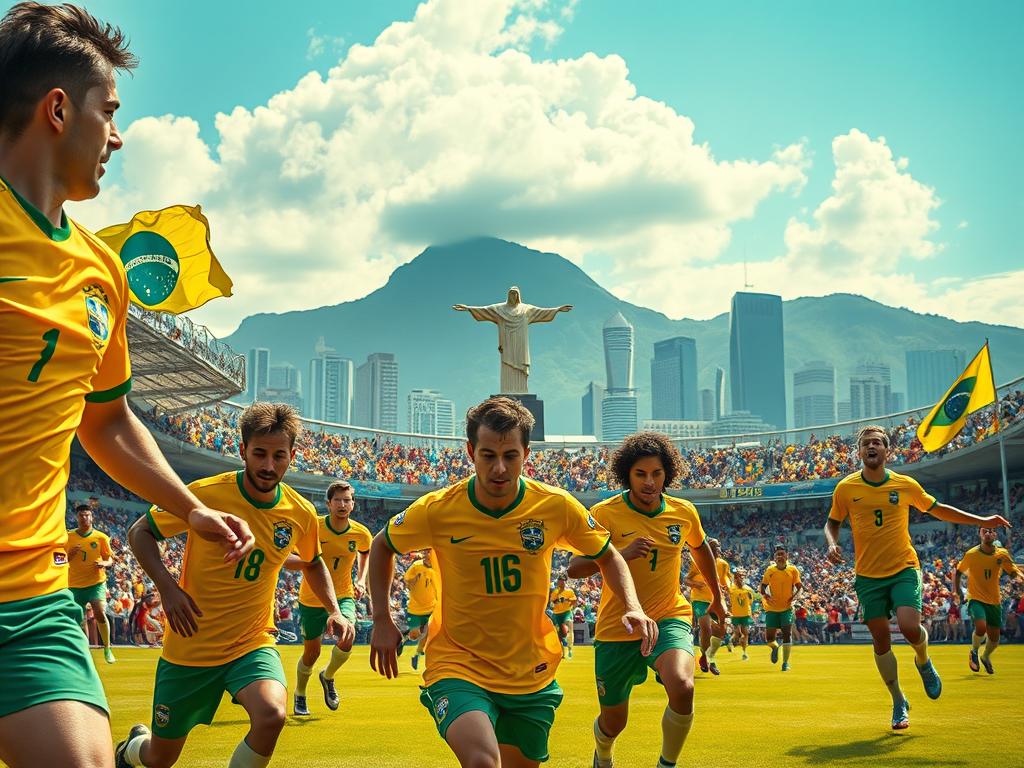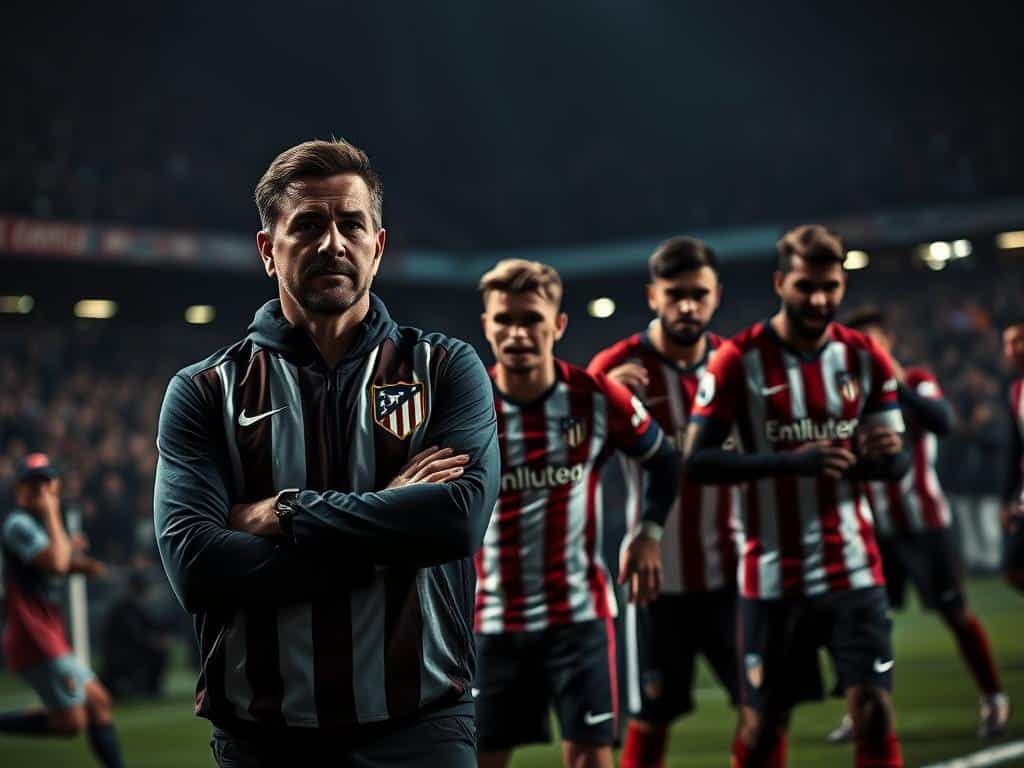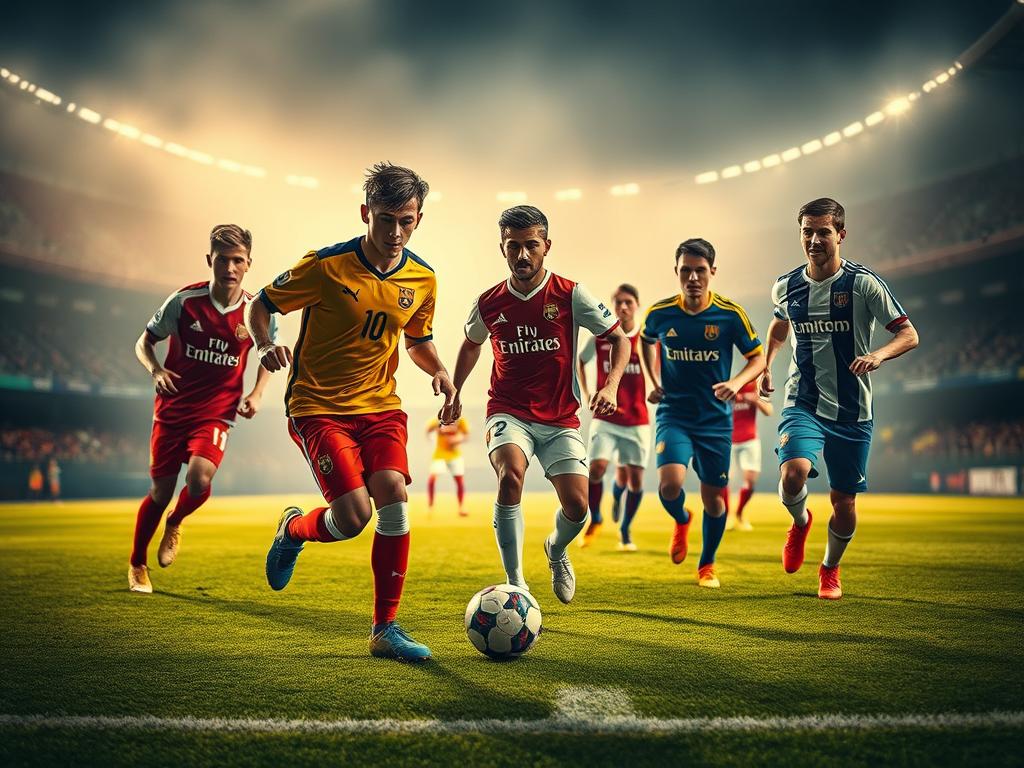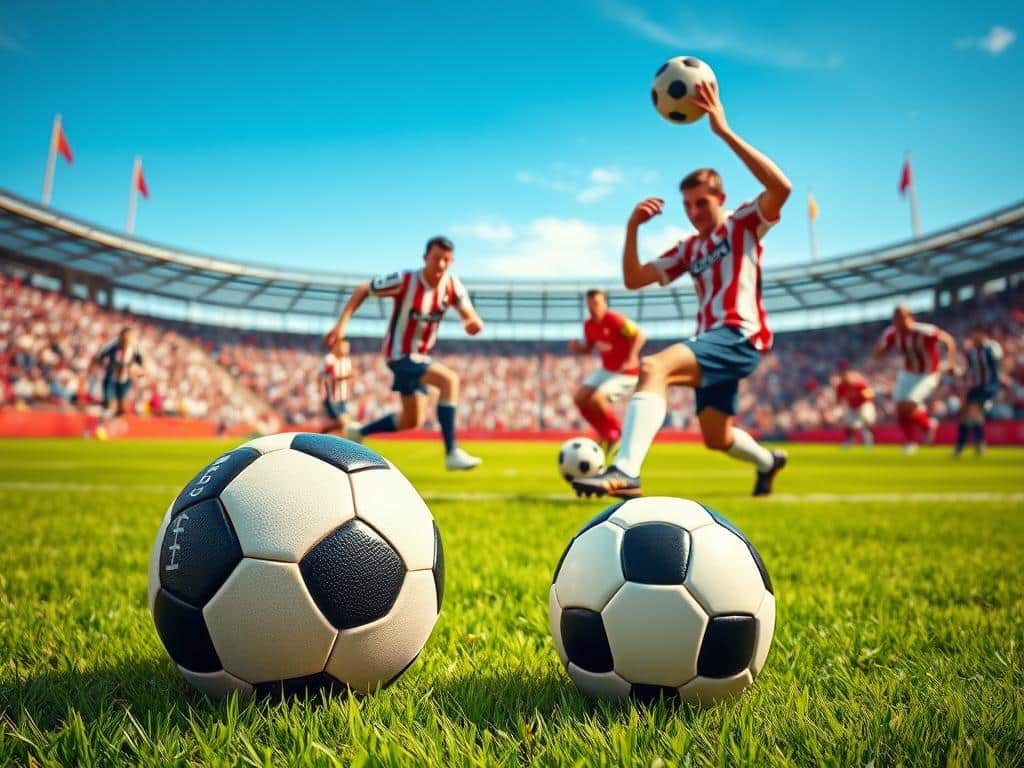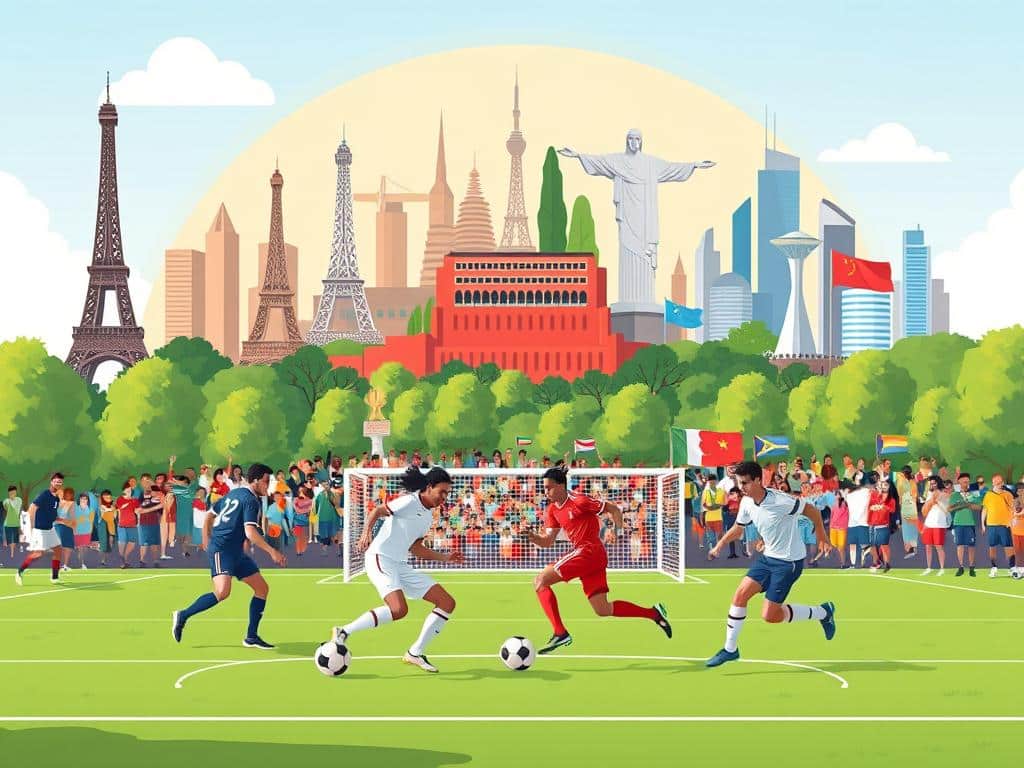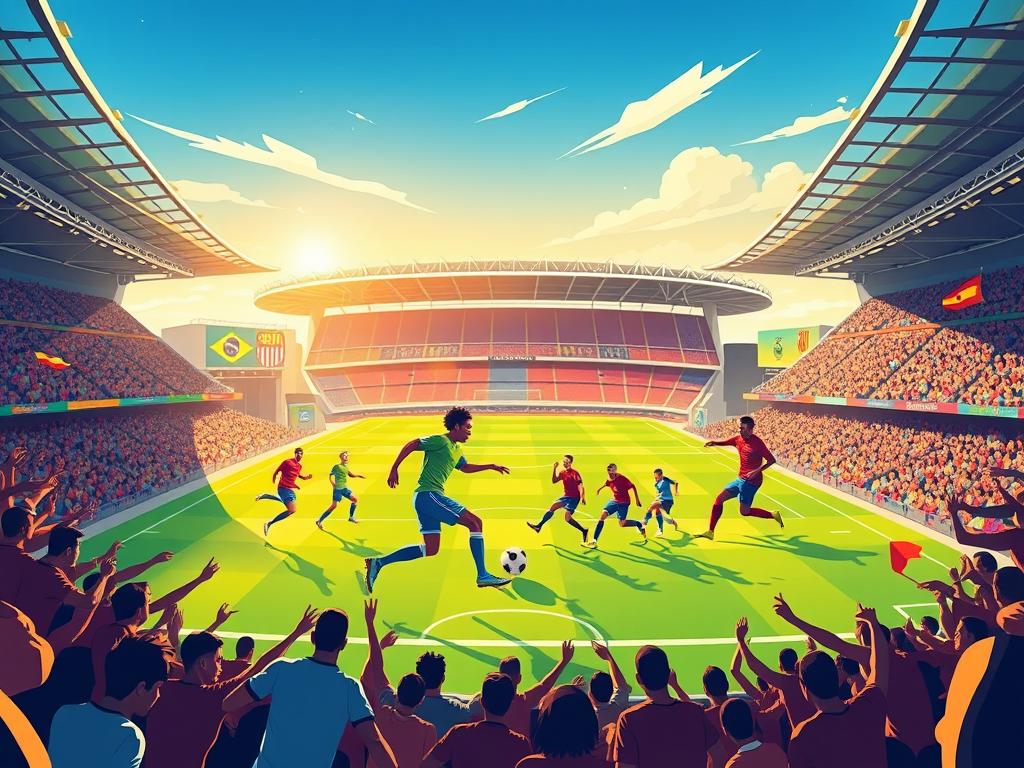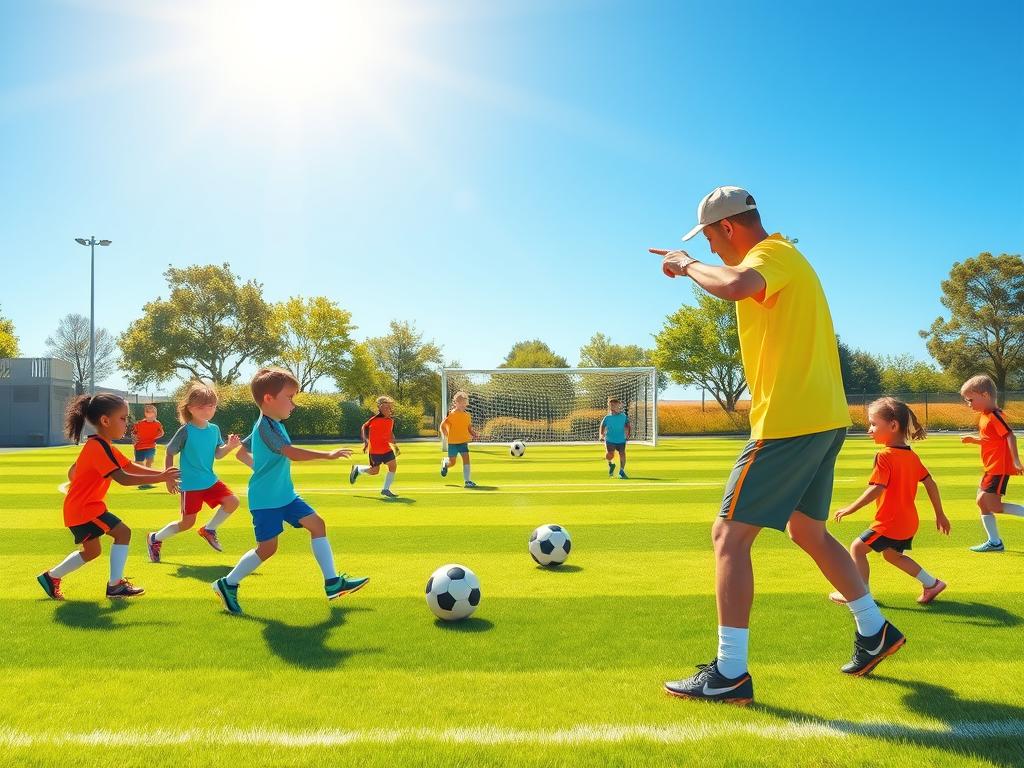Did you know one country has lifted the World Cup trophy five times? That’s more than any other nation in football history. Their golden legacy spans decades, filled with jaw-dropping goals, iconic players, and unforgettable moments.
From Pelé’s magic in 1958 to Ronaldo’s dominance in 2002, this team redefined excellence. They’re the only squad to win the tournament on four continents. Their flair, known as Jogo Bonito (the beautiful game), inspired millions worldwide.
Beyond the World Cup, they’ve claimed nine Copa América titles and four Confederations Cups. Every match showcases skill, passion, and a relentless pursuit of victory. Whether you’re a casual fan or a die-hard supporter, their story is worth celebrating.
Let’s dive into the triumphs, heartbreaks, and legendary players that shaped football’s most storied team.
Introduction: The Legacy of Brazilian Football
The yellow jersey isn’t just a uniform—it’s a symbol of footballing excellence. Since 1914, this nation has crafted a history unlike any other, blending raw talent with joyous creativity. Their nickname, Seleção Canarinho, reflects the vibrant spirit that defines their game.
From amateur roots to global dominance, their 110-year journey is a masterclass in evolution. The iconic yellow kit emerged after the 1950 heartbreak, turning pain into pride. Today, they hold a FIFA ranking of 5th, with modern stars like Vinícius Jr. carrying the torch.
Football here is more than sport—it’s woven into the cultural fabric. Streets buzz with pick-up games, and kids dream of becoming the next Pelé or Neymar. The rivalry with Argentina fuels endless drama, while clashes with Germany rewrite history books.
- Unbeatable records: 76 World Cup wins, 247 tournament points.
- Golden sweep: 2016 Olympics completed their FIFA trophy collection.
- 35-match streak: A 1996-2021 run showcasing consistency.
Tactics evolved from samba flair to structured brilliance, yet the essence remains: play beautifully, win relentlessly. As new talents rise, they chase past glories—proving the legacy is alive and kicking.
The Early Years: Humble Beginnings (1914-1930)
Football history often overlooks the gritty origins of legendary teams. Over a century ago, matches were played on uneven pitches with leather balls that weighed a ton when wet. The brazil first international game in 1914 against England’s Exeter City ended in chaos—officials disputed the score (2-0 or 3-3), and local papers debated for weeks.
First International Matches
Back then, only players from Rio or São Paulo made the squad. Travel was grueling, and tactics? Basic. Fans cheered for Arthur Friedenreich, the first mixed-race icon who dodged racism to become a hero. His goals in friendlies proved the nation’s potential, even without a proper league.
1919 and 1922 South American Championships
The 1919 Copa América final was a nail-biter. Friedenreich’s extra-time strike beat Uruguay 1-0, sparking street parties. But 1922’s win came with riots—fans clashed, and referees needed police escorts. Despite the glory, a 27-year trophy drought followed.
Those early years ago were raw. Players worked day jobs, and matches ended at sunset. Yet, they set the stage for the first world cup dreams. The CBF’s 1914 founding gave structure, but the real magic came from the streets—where kids still mimic Friedenreich’s flicks today.
The 1930s: Brazil’s First World Cup Appearance
Imagine sailing for weeks just to play in the first-ever FIFA World Cup. That was reality for Brazil’s squad in 1930. Their journey to Uruguay involved cramped ships and makeshift training—far from today’s luxury charters.
1930 World Cup in Uruguay
Brazil’s debut was a rollercoaster. They crushed Bolivia 4-0, with Preguinho scoring their first World Cup goal. But the group stage ended bitterly—a 2-1 loss to Yugoslavia. Poor defending and travel fatigue took their toll.
1934 and 1938 World Cups
In 1934, most South American teams boycotted the tournament in Italy. Brazil went alone, losing 3-1 to Spain. But 1938 unveiled a star: Leonidas da Silva, the “Black Diamond.” His seven goals dazzled fans, including a barefoot strike against Poland.
The semifinal against Italy was shadowed by politics. Mussolini’s regime pressured referees, and Brazil fell 2-1. Still, they were the only non-European team to reach the quarterfinals. Their white kits (later swapped for yellow) symbolized a team finding its identity.
- Primitive prep: No scouts, no diets—just raw talent.
- 1938 breakthrough: Leonidas’ flair foreshadowed Brazil’s future dominance.
- Kits to legacy: Plain designs evolved into iconic jerseys.
These early struggles forged resilience. By 1938, Brazil proved they belonged—setting the stage for postwar glory.
The Maracanazo: Heartbreak in 1950
Few moments in sports history sting like Brazil’s 1950 World Cup collapse. Hosting the tournament for the first time, they were favorites—until Uruguay ripped the trophy away in front of 200,000 devastated fans.
The 1950 World Cup Final
Brazil dominated the group stage, thrashing Sweden 7-1 and Spain 6-1. The final wasn’t even a knockout match—a draw would’ve crowned them champions. But Uruguay’s Alcides Ghiggia scored the winner in the 79th minute, silencing the Maracanã.
Fans had already celebrated. Newspapers printed victory editions. The shock triggered national mourning—some even took their own lives. A sculptor’s planned monument to the “champions” was abandoned mid-project.
Impact on Brazilian Football
The loss haunted the national football team for decades. They ditched white jerseys for iconic yellow, symbolizing rebirth. The 1954 squad played with fear, crashing out early.
- Cultural reset: Football became a science, not just art.
- Redemption arc: The 1958 World Cup win healed wounds.
- Legacy: “Maracanazo” is now shorthand for sporting agony.
This wasn’t just a match—it was a national identity crisis. Yet from the ashes rose Pelé’s golden era, proving heartbreak can fuel greatness.
Pelé and the First Golden Era (1958-1970)
At 17, a kid from Minas Gerais rewrote football history forever. Pelé’s rise marked the start of a golden age—three World Cup wins in twelve years. This wasn’t just dominance; it was artistry mixed with ruthless precision.
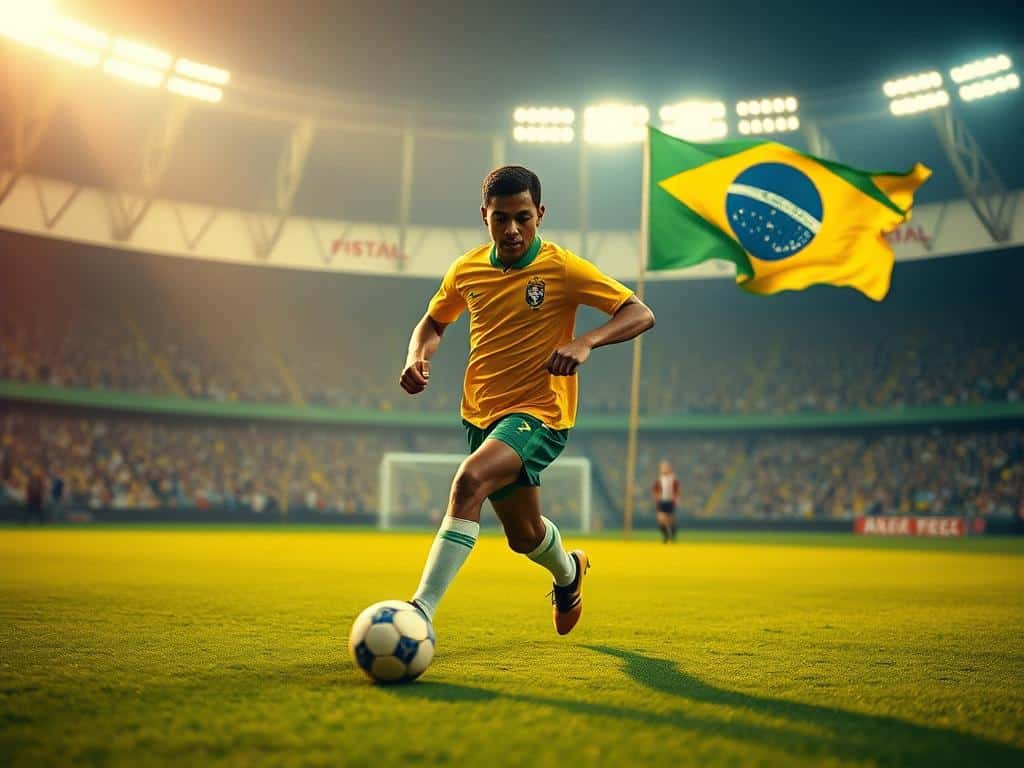
1958 World Cup: Brazil’s First Title
Coaches doubted Pelé’s knee, but his talent was undeniable. In Sweden, he stunned the football team’s critics with six goals. The final against Sweden? A 5-2 masterpiece. His header—floated like a feather, nailed like a hammer—sealed the deal.
Before kickoff, Garrincha and Pelé tormented the USSR in just three minutes. Dribbles, backflips, and pure chaos. The world gaped. This was the 1958 World Cup—where legends were born.
1962 World Cup: Garrincha’s Triumph
Pelé got injured, but Garrincha turned into a one-man circus. Chile watched him nutmeg defenders, then score twice in the semifinal. The final against Czechoslovakia? A 3-1 victory fueled by his crooked genius.
Opponents kicked him. Referees ignored it. Fans cheered louder. By 1966, brutal tackles ended Pelé’s tournament early. But 1962 proved Brazil’s depth—no star? No problem.
1970 World Cup: The Greatest Team Ever?
Six wins. Nineteen goals. Zero doubts. The 1970 squad played world football on fast-forward. Carlos Alberto’s final goal? A team move so perfect, it’s still studied today. Jairzinho scored in every game. Pelé, now a maestro, pulled strings like a puppeteer.
Their 4-2-4 formation blended samba flair with military discipline. FIFA retired the Jules Rimet Trophy after their third win. Debate all you want—this team’s highlights are the closest thing to football heaven.
The Dry Spell: Struggles and Near Misses (1974-1990)
For 24 long years, the world waited for a familiar yellow blaze of glory. After the 1970 triumph, Brazil entered an era of heartbreaks—close calls, tactical overhauls, and unforgettable what-ifs.
1974 and 1978 World Cups
1974 hurt. Facing Cruyff’s Netherlands, Brazil’s samba style met Total Football’s ruthlessness. A 2-0 loss exposed defensive gaps. Four years later, controversy struck. Needing a 4-goal win to advance, Peru collapsed 6-0 to Argentina—a result still whispered about today.
The 1982 World Cup: A Team Remembered
Fans still debate that midfield—Sócrates, Falcão, Zico. Their flair was unstoppable… until Paolo Rossi’s hat-trick for Italy. A 3-2 loss in Barcelona crushed dreams, but this squad became legends. They played the “beautiful game” even in defeat.
1986 brought Careca’s counterattacks and Branco’s 40-yard rocket against the Dutch. Yet penalties vs. France ended the run. By 1990, pragmatism replaced flair. Dunga anchored midfield, but Maradona’s Argentina delivered the final blow.
- 1974: Outclassed by Total Football’s precision.
- 1982: Golden time of flair, but no trophy.
- 24-year gap: The longest title drought in modern history.
This era wasn’t failure—it set the stage for 1994’s redemption. Sometimes, the falls make the climb back sweeter.
The Second Golden Era: World Cup Dominance (1994-2002)
Redemption came in waves between 1994 and 2002, rewriting a story of heartbreak into glory. This era blended tactical grit with flashes of genius, proving beauty and efficiency could coexist.
1994 World Cup: Redemption in the USA
Critics called them too defensive, but the 1994 world cup squad silenced doubters. Romário and Bebeto’s partnership delivered 8 goals, including their iconic “rock the baby” celebration. The final against Italy? A nerve-wracking 0-0 draw—the first decided by penalties.
Roberto Baggio’s sky-high miss symbolized their triumph. Coach Parreira’s 4-4-2 system prioritized stability, a stark contrast to the 1982 flair. For fans, it wasn’t just a win world cup moment—it healed the scars of 1950.
1998 World Cup: Ronaldo’s Heartbreak
Hours before the final, Ronaldo suffered a seizure. The world cup team initially listed him as benched, then reversed the decision. A ghost of his usual self, he watched France’s 3-0 victory in a daze.
Questions linger: Did pressure break them? Or was Zidane simply unstoppable? Either way, the loss fueled Ronaldo’s 2002 revenge arc.
2002 World Cup: The Three R’s Shine
Ronaldo, Rivaldo, and Ronaldinho—the “Three R’s”—were poetry in motion. Ronaldinho’s 40-yard free kick against England defied physics. Ronaldo’s 8 goals, including a final brace against Germany, sealed their fifth title.
Coach Scolari’s secret? Psychological prep. He made players visualize lifting the trophy daily. The result? A perfect 7-win run, outscoring opponents 18-4.
Debates rage: Was this squad better than 1970’s? One thing’s clear—they turned near-misses into a golden decade, inspiring Neymar’s generation to chase the same highs.
Brazil National Soccer Team Achievements in Copa América
Nine golden trophies tell a story often overshadowed by World Cup glory. The Copa América has been a proving ground for legends since 1919, where flair meets fierce rivalry. While the world watches global tournaments, this continental battle forged the skills that made stars like Pelé and Neymar household names.
Unlike the World Cup’s four-year wait, the South American Championship (as it was originally called) tested players annually. The format changed over time, but the passion never faded. From Friedenreich’s heroics to Tite’s tactical mastery, each victory added chapters to football’s richest legacy.
Early Successes (1919-1949)
Arthur Friedenreich didn’t just score goals—he broke barriers. The mixed-race forward dominated the 1919 tournament, netting the winner in the final against Uruguay. His MVP performance came on muddy pitches with crowds so rowdy, players needed police escorts.
After a 27-year drought, the 1949 squad reignited the flame. Post-war Brazil hosted the event, crushing Paraguay 7-0 in the final. Ademir’s four goals signaled a resurgence, proving continental dominance could translate globally.
Modern Triumphs (1989-2019)
Romário announced himself in 1989 with three goals, including a semifinal strike against Argentina. The 2-0 final victory over Uruguay showcased a new generation’s grit. Eight years later, Ronaldo’s blistering pace earned him Player of the Tournament honors.
Robinho’s six-goal 2007 campaign and the 2019 home triumph under Tite bookended a golden modern era. The latter victory—sealed with a 3-1 win over Peru—proved even without Neymar, the team‘s depth could deliver silverware.
As the 2024 edition approaches, one question lingers: Can this squad add a tenth star to the most decorated cabinet in Copa América history? The answer, as always, will be written on the pitch.
Legendary Players Who Defined Brazilian Football
Some players don’t just play football—they redefine it for generations. From Pelé’s magic to Neymar’s flair, these icons turned the pitch into a stage. Their stories aren’t just about goals; they’re about joy, resilience, and unforgettable moments.
Pelé: The King of Football
Three World Cups. Twelve hundred career goals. Pelé wasn’t just a player—he was a force of nature. At 17, his 1958 debut stunned Sweden with a hat-trick. By 1970, his no-look passes and bicycle kicks became the gold standard.
His 77 goals for the Seleção stood for years as a record. But numbers don’t capture his impact. Pelé made football art, blending power with grace. Even opponents asked for his jersey mid-game.
Garrincha: The Joy of the People
Bent legs, endless dribbles, and a smile that lit up stadiums. Garrincha played like the ball was glued to his feet. In 1962, with Pelé injured, he carried the team to victory—scoring twice in the semifinal.
His tricks defied physics. Defenders tripped over air trying to stop him. Off the pitch, his charisma made him a folk hero. Proof that greatness isn’t about perfection—it’s about passion.
Ronaldo, Ronaldinho, and Neymar
The modern era brought new legends. Ronaldo’s 15 World Cup goals came after knee surgeries that would’ve ended most careers. Ronaldinho’s free kicks and smile made him a fan favorite.
Neymar? A record-chaser with 79 goals (and counting). His flair divides opinions, but his talent is undeniable. Together, they kept the magic alive—proving the beautiful game evolves but never fades.
- Zico: Free-kick maestro with 48 goals.
- Romário: Claimed 1,000 goals (even if math disagrees).
- Cafu: Captain with 142 caps—leadership personified.
From dusty favela pitches to global stardom, these legends remind us: football isn’t just a sport. It’s a way of life.
The 2006-2014 Era: Challenges and Transition
Between 2006 and 2014, football fans witnessed both brilliance and heartbreak. This period tested the brazil world football identity like never before. From stacked squads to shocking defeats, these years reshaped tactics and player development.
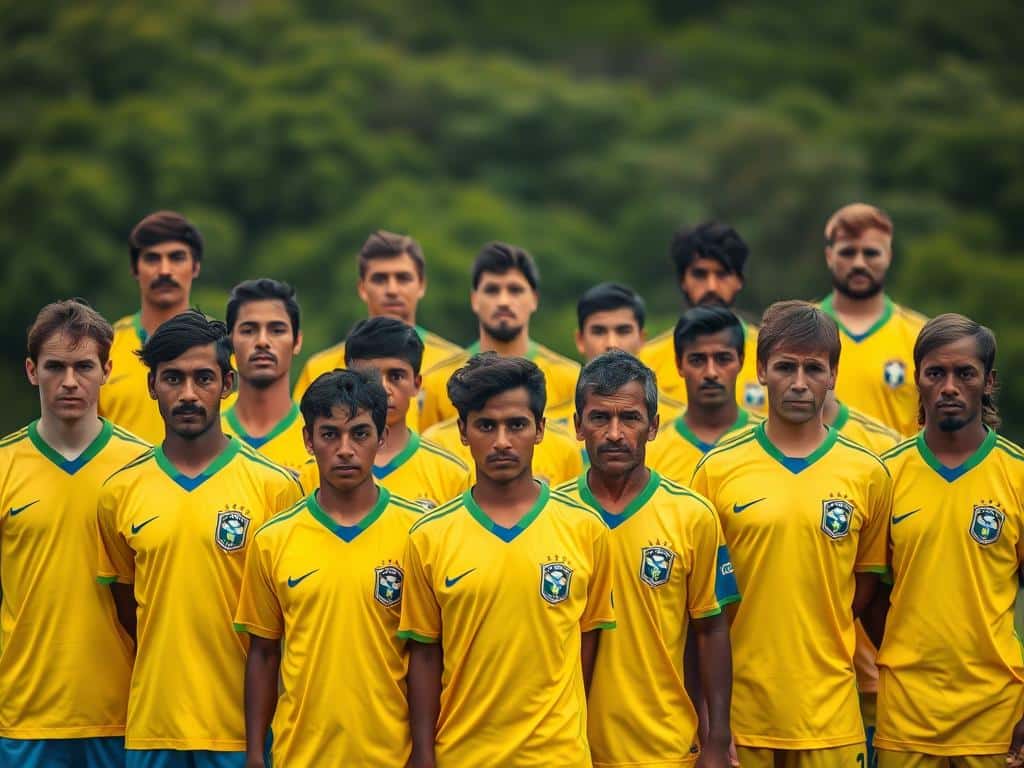
2006 World Cup: The Magic Quartet
The “Magic Quartet” of Ronaldo, Adriano, Ronaldinho, and Kaká promised fireworks. Yet their attacking imbalance left midfield exposed. Kaká’s red card against Ivory Coast summed up their frustration—a moment of brilliance followed by discipline lapses.
Despite topping their group stage, France outmaneuvered them 1-0 in the quarterfinals. Zidane’s masterclass exposed tactical rigidity. The lesson? Star power alone couldn’t guarantee glory.
2010 World Cup: Quarter-Final Exit
2010 brought another painful exit. Felipe Melo’s own goal against the Netherlands turned the tide in a 2-1 loss. The midfielder’s red card minutes later compounded the misery.
Coach Dunga’s pragmatic approach drew criticism. The squad lacked creative spark when trailing. This defeat sparked debates about abandoning traditional flair for European-style efficiency.
2014 World Cup: The 7-1 Humiliation
No result shocked fans like the 7-1 semifinal loss to Germany. Without Neymar (injured) and Thiago Silva (suspended), the defense collapsed. Neuer’s sweeper-keeper role magnified their tactical naivety.
Oscar’s late consolation couldn’t mask the trauma. Social media erupted—this was the most-tweeted sports event ever at the time. The “Mineirazo” became shorthand for sporting nightmares.
- System reset: 2013 Confederations Cup win masked deeper issues
- Record low: FIFA ranking dropped to 22nd in 2013
- Legacy: Forced complete overhaul of youth development
These eight years proved even football giants must adapt. The world cup losses became catalysts for change—setting the stage for future redemption.
Recent Performances: 2018 and 2022 World Cups
Modern football demands more than talent—it’s about adapting under pressure. The past two FIFA World Cup tournaments tested the Seleção’s ability to evolve. While moments of brilliance shone through, quarter-final exits left fans craving more.
2018: Another Quarter-Final Exit
Belgium’s 2-1 win in Kazan was a tactical masterclass. Neymar, battling ankle injuries, couldn’t spark his usual magic. Coutinho’s long-range strikes in the group match against Switzerland and Serbia hinted at promise, but Roberto Martinez’s defense stifled Brazil’s creativity.
Casemiro’s suspension hurt. Fernandinho’s own goal summed up a frustrating night. Tite’s 4-3-3 system, dominant in qualifiers, looked predictable against Europe’s best.
2022: Seeking Redemption
Richarlison’s bicycle kick against Serbia went viral, but Croatia’s penalty shootout win dashed hopes. Neymar’s extra-time goal seemed decisive—until Bruno Petković’s 117th-minute equalizer. Rodrygo’s missed penalty in the shootout marked a cruel end.
New stars emerged. Vinícius Jr.’s dribbling terrorized defenses, while Rodrygo showed clutch gene. Yet, comparisons to 2002’s preparation were inevitable. Back then, Scolari’s psychological drills created unity. In 2022, the squad lacked that edge.
- 2026 vision: With the World Cup expanding to 48 teams, younger players like Endrick could shine.
- Tactical shift: Tite’s hybrid 4-2-4 tried balancing flair and pragmatism.
- Legacy: These near-misses fueled hunger for the next golden generation.
Brazil’s Rivalries: Matches That Shaped History
Rivalries define football’s soul—where legends clash and history writes itself. For this nation, clashes with Argentina and Germany aren’t just games. They’re cultural showdowns that divide households and redefine eras.
Brazil vs. Argentina: The Superclássico
Picture Neymar dribbling past Messi—club teammates turned rivals. Their 110-match history (43W-42L) is football’s fiercest chess match. The 1982 World Cup saw Zico’s brilliance overshadowed by Maradona’s physicality. Fast-forward to 1999’s Copa América brawl—red cards flew like confetti.
Maradona’s “Hand of God” in 1990 still stings. Yet Brazil’s 2007 Copa América 3-0 revenge, with Robinho’s hat-trick, proved no feud stays one-sided. Today, fans debate: Is Messi’s finesse deadlier than Neymar’s flair?
Brazil vs. Germany: A Tale of Two Finals
2002’s World Cup final was Ronaldo’s redemption. His two goals against Kahn’s Germany healed 1998’s heartbreak. Twelve years later, the 7-1 Mineirazo became a national trauma. Neuer’s sweeper-keeper role exposed defensive gaps still analyzed today.
Yet Olympic finals flip the script. Brazil’s 2016 gold-medal win (Neymar’s clinching penalty) and 2021 repeat (Richarlison’s hat-trick) showed resilience. The lesson? Rivalries evolve—but the fire never fades.
- Fan cultures: Argentinians sing; Brazilians samba.
- 2026 potential: A semifinal rematch could rewrite history.
- Legacy: These games don’t just test skill—they reveal character.
In football, the way you win—or lose—against rivals defines generations. For Brazil, every clash is a chance to reignite the beautiful game’s fiercest debates.
The Tactical Evolution of Brazilian Football
Football isn’t just played; it’s choreographed—and these maestros rewrote the playbook. Over time, their approach shifted from street-smart flair to data-driven precision. Each era’s system reflected cultural identity as much as competition demands.
From Samba Style to Pragmatism
The 1950s M-shaped attack let Pelé roam freely, while Zagallo tracked back—a revolutionary 4-2-4. By 1982, Tele Santana’s midfield triangle (Sócrates, Falcão, Zico) turned matches into art shows. They completed 30-pass moves before scoring.
1994 changed everything. Dunga and Mauro Silva formed a double pivot, shielding the defense. Parreira’s 4-4-2 prioritized clean sheets over carnival football. The result? A first World Cup in 24 years.
Influential Coaches and Systems
Scolari’s 2002 3-5-2 used wingbacks to overload flanks. Tite later blended German gegenpressing with futsal-inspired close control. Today’s hybrid 4-3-3 borrows from Pep Guardiola’s positional play.
- Futsal’s fingerprint: Neymar’s heel chops and Vinícius’ tight-space dribbling
- Data revolution: GPS trackers now optimize player workloads
- Next wave: AI-assisted scouting finds the next Ronaldo
The beautiful game still lives here—just with smarter blueprints. As tactics evolve, one truth remains: this team will always play to win hearts first, trophies second.
Brazil’s Influence on Global Football Culture
From favela streets to FIFA video games, their style transcends borders. The beautiful game became a cultural export, blending athleticism with artistry. You’ve seen their flair in local parks—heel chops, no-look passes, and samba celebrations.
The Jogo Bonito Philosophy
Beach football and futsal labs birthed this magic. Narrow courts forced quick thinking—Ronaldinho’s elasticos came from dodging concrete walls. Nike’s Joga Bonito campaigns showcased these street-smart moves worldwide.
The 1970 team’s flowing attacks became textbook examples. Today, kids from Tokyo to Texas try copying Neymar’s rainbow flicks. This isn’t just playing—it’s performing.
Football in Popular Culture
Films like Pelé: Birth of a Legend turned struggles into inspiration. FIFA games consistently rate their players highest for creativity. Even goal celebrations became global dances—the world copied Bebeto’s rocking baby move in 1994.
- Fan displays: Carnival vibes with giant flags and drum circles
- Jersey sales: Yellow kits top charts from Madrid to Mumbai
- Social media: Vinícius Jr.’s TikTok tutorials teach freestyle skills
Every World Cup anthem borrows samba beats. Stadiums now host capoeira performances at halftime. This isn’t just a sport—it’s a movement that keeps evolving.
Records and Milestones: Brazil’s Football Legacy
Numbers don’t lie—some football records seem almost impossible to break. The yellow-and-green legacy isn’t just about trophies; it’s about rewriting the history books with every match. From teenage wonders to ironman captains, these milestones set the standard for excellence.
Dominance on the Global Stage
Five stars above the crest tell part of the story. No nation has won more World Cup titles, with victories spanning 1958 to 2002. The 35-match unbeaten streak (1996-2021) showcased consistency rarely seen in modern football.
Goal difference matters too. A staggering +129 across tournaments proves attacking flair isn’t just entertaining—it’s lethal. The 247 all-time points record? That’s 20% higher than second-place Germany.
Players Who Redefined Greatness
Pelé’s 1958 final heroics made him the youngest scorer at 17. Cafu later achieved the unthinkable—three consecutive finals (1994-2002). Ronaldo’s 15 goals across four tournaments remain unmatched by any modern striker.
Beyond men’s football, Marta’s 17 World Cup goals for the women’s squad broke gender barriers. Her technical brilliance inspired a generation to dream bigger.
- Olympic distinction: Only nation with back-to-back golds (2016, 2021)
- Confederations Cup: Four titles proving dominance between World Cups
- Neymar’s chase: Needs 18 goals to surpass Pelé’s national record
These aren’t just stats—they’re chapters in football’s greatest story. As new stars emerge, the records remind us why this legacy endures.
The Future of Brazilian Football
What does tomorrow hold for the most decorated football nation on earth? The pipeline of talent suggests the golden era isn’t over—it’s evolving. From teenage phenoms to tactical innovations, the next chapter promises excitement.
Stars Writing New Legends
Vinícius Jr. isn’t just Real Madrid’s winger—he’s a Ballon d’Or contender reshaping modern attacks. His 23 goals last season proved flair and end product can coexist. At 23, his ceiling seems limitless.
Then there’s Endrick. Palmeiras’ $60M gem becomes Real Madrid’s problem in 2024. His left foot generates YouTube compilations weekly. Comparisons to Ronaldo seem bold until you see his off-ball movement.
Don’t sleep on midfield maestros either. Andrey Santos (Chelsea) bosses the engine room like a 30-year-old veteran. Savio’s dribbling at Girona shows why City Group invested early.
Obstacles on the Path
Goalkeeping remains a concern. European clubs dominate youth development, leaving few top-tier shot-stoppers at home. Infrastructure gaps also show—some academies lack basic GPS tracking systems.
Corruption scandals at the CBF damaged trust. Reforms are underway, but progress is slow. Stadiums need upgrades too, especially for the 2027 Women’s World Cup bid.
The women’s game is rising fast though. Marta’s legacy inspired a generation—now clubs are investing in youth systems. In coming years, expect more Debinhas and Kerolins on global stages.
Time will tell if this mix of talent and reforms delivers. But one thing’s certain: the world will watch closely when the team chases glory in 2026 and beyond.
Brazil’s Enduring Legacy in the Beautiful Game
Football’s heartbeat pulses strongest where passion meets skill. Five World Cup crowns stand as proof—a blend of artistry and relentless drive. From Pelé’s magic to Neymar’s flair, each era redefined excellence.
The *Jogo Bonito* philosophy changed the way we see the sport. Street games birthed legends, while futsal sharpened their creativity. Today, Vinícius Jr. and Endrick carry the torch, proving talent pipelines never dry up.
You’ll find their influence everywhere—from playground tricks to Ronaldinho’s legacy in modern playmakers. The future? Bright. The 2026 stage awaits, and the world will watch.

